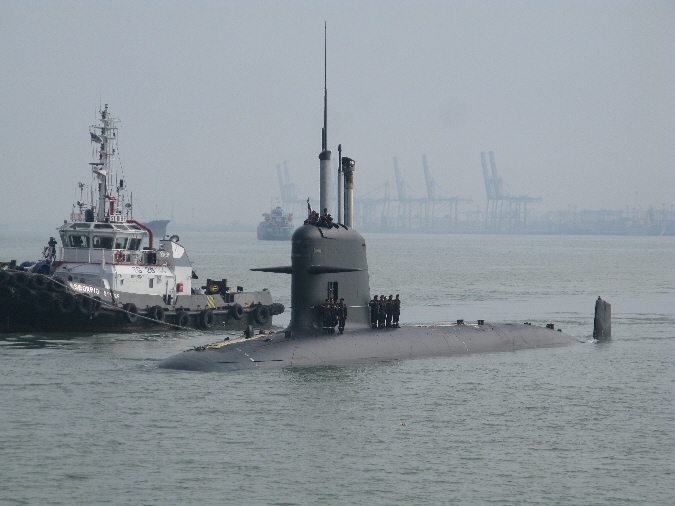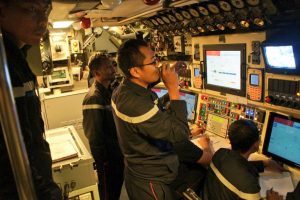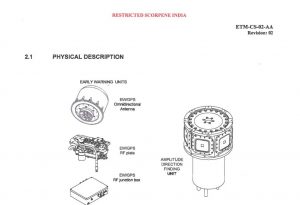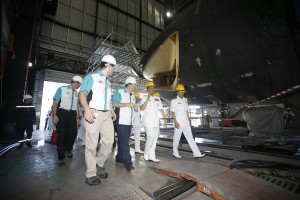
SHAH ALAM: The data for the Indian Scorpene submarines – an updated version of the RMN Perdana Menteri class – have been leaked. The Australian, a newspaper based in Melbourne – however choose to claim that the leak data may well compromise their own submarine design also built by the French ship builder, DCNS.
The stunning leak, which runs to 22,400 pages and has been seen by The Australian, details the entire secret combat capability of the six Scorpene-class submarines that French shipbuilder DCNS has designed for the Indian Navy.
A variant of the same French-designed Scorpene is also used by the navies of Malaysia, Chile and, from 2018, Brazil, so news of the Edward Snowden-sized leak — revealed today — will trigger alarm at the highest level in these countries. Marked “Restricted Scorpene India”, the DCNS documents detail the most sensitive combat capabilities of India’s new $US3 bn ($3.9bn) submarine fleet and would provide an intelligence bonanza if obtained by India’s strategic rivals, such as Pakistan or China.

The same article also linked to the data leaked though it claimed it had redacted some of the information. The Australian also claimed that the data was taken out from DCNS by a sub-contractor, a former French navy officer, who it claimed took it to South East Asia.

However, The Australian has been told that the data on the Scorpene was written in France for India in 2011 and is suspected of being removed from France in that same year by a former French Navy officer who was at that time a DCNS subcontractor.
The data is then believed to have been taken to a company in Southeast Asia, possibly to assist in a commercial venture for a regional navy.
It was subsequently passed by a third party to a second company in the region before being sent on a data disk by regular mail to a company in Australia. It is unclear how widely the data has been shared in Asia or whether it has been obtained by foreign intelligence agencies.

Meanwhile, Defense News is reporting that the French plans an inquiry into the leak.
“DCNS has been made aware of articles published in the Australian press related to the leakage of sensitive data about (the) Indian Scorpene,” the company told Defense News.
“This serious matter is thoroughly investigated by the … French national authorities for defense security,” DCNS said. “This investigation will determine the exact nature of the leaked documents, the potential damages to DCNS customers as well as the responsibilities for this leakage,” the company said.”
Personally, I think the data leak should be a serious concern for RMN especially that it came out from DCNS albeit via a sub contractor. And the claim that the data leak was somehow connected to a regional navy is a serious one indeed.
Its still too early for RMN to make any comments. If they do, I will post it here. Edited to add RMN comments.
RMN chief Admiral Kamarulzaman Badaruddin today (Aug 25) downplayed the concerns stating that the Perdana Menteri class submarines had different specifications compared to the Indian Scorpenes or even the Chilean ones.
He is correct of course but ours are more similar to the Chilean ones as both submarines are not fitted with air-independent propulsion. The Indian Scorpenes are longer and heavier in displacement, due to the AIP. The Indian submarines is fitted with non-penetrating periscopes while ours are fitted with the older hull penetrating ones.
— Malaysian Defence.
If you like this post, buy me an espresso. Paypal Payment


clearly,it is a very serious threat ever to our own scorpene fleet.
Imagine if several SEA navy had a copy of that sensitive details.
Wah… somebody forgot to apply DLP software somewhere? If it happened in India, just imagine the irony of it.. one of the biggest infotech industry provider having this kind of data breach in their own backyard.
But if it happened at DCNS.. well..
On the contrary, I don’t think it compromises our boats in a major way. Sure, the info shouldn’t have been leaked and is info that some would like to get but it doesn’t mean that the Scorpenes have been made totally vulnerable.
French defense industry are getting more contracts from clients..they should anticipates all these kind of threats since many us/russian tradition buyer divert to french products ..
Sabotage, spying , very synonym in military industry.
Track those who leak them..i believe china willing to pay millions for the document..
They work lightning fast , look at how they obtain us f117, drone ,stealth heli wreckage
buzzer – ”They work lightning fast , look at how they obtain us f117, drone ,stealth heli wreckage”
If you have the budget and a wide network of people abroad who are willing to steal or buy or help get info for you then there’s no surprises that China can do what it does. A lesson learnt from the Cold War is that just because you get hold of a particular system or technology; doesn’t mean you’ll be able to duplicate or exploit it to your benefit. The Soviets got various Western made gear [the Iranians for example provide a Phantom and a Phoenix to the Soviets and ERA was obtained via the Syrians from a knocked out IDF M-60] but some they could not exploit or take advantage of because they didn’t have the technology. China is reported to have gotten parts of Tomahawks that were used on Afghanistan in 1998 [via the Pakistanis] and parts of the F-1117 that was shot down in Serbia : whether they actually benefited is the question.
Guess that more or less mean no more Scorpene for RMN… Then again, given that Scorpene is a commercially available platform, probably no life or death “super” capabilities/technologies that are not already known or within predictions is at stake… Compromised? Sure, but with just two units, probably not game changing in any significant scenarios…
Indonesia has been talking to dcns about the scorpene. With this very sensitive information out in the open, other navies like Singapore, Indonesia, Vietnam or China could just use the data to easily detect and classify a target as a malaysian scorpene submarine. Hopefully during the refit some technological updates is included and render the data not as similar to the malaysian scorpenes.
This release of the data will have no bearing when the times comes for the RMN to get additional subs. The main means of detecting the Scorpenes when submerged will remain its acoustic signature and various countries already have the Scorpenes acoustic signature; taken during bilateral exercises, when the boats were on their way home and when they are on deployment. Stuff like diving depths, range and endurance; speed and conditions needed for using the periscope, radiated noise levels when the submarine surfaces, etc, are indeed useful to have and will aid in predicting how the boats will operate but by themselves will not make the Scorpenes vulnerable to detection. How easy it will be to detect the Scorpenes, based on the leaked data will also depend on acoustic conditions, intel, the quality of sonar used by the opposition, as well as other factors, including the fact that different users will operate their boats in different ways : the leaked data by themselves are not a ”game changer” and have not made the Scorpenes vulnerable overnight….
Quite often, a lot a vital data is obtained not by espionage or leaked stuff but by the exchange of info, i.e. in a few years what’s stopping India from providing certain data [data that by themselves will not make much of a difference] on the Scorpenes to a 3rd party in exchange for info of a different kind. Also, by using open source literature, including marketing info provided by the OEM; those in the game are able to fairly accurately predict various technical aspects of not only the Scorpene but also other designs. Another thing to bear in mind is that the IN’s Scorpenes will have slightly different specs compared to ours; just like like how ours are slightly different from Chiles’s and has stuff that Chile doesn’t, i.e. a watertight cofferdam section and extra displays in the CMS.
I don’t know what to say about the damage caused. But it is reasonable to believe that if you know the sound signatures of your target submarine, you can focus your sonar on a narrow band of sound frequencies rather than a wide range. You may even know the thermal layer that is optimal for concealing that submarine is, and focus your effort in that layer. The knowledge might even help you make the decision on the next sonar to buy.
You might obtain some of this information from the leak or you might already have it. Then there’s some information that doesn’t affect us because our subs or environments are different. For example the knowing the maximum depth may not be useful for a submarine operating in the South China Sea, considering how shallow it is.
Sub-system or soft system might be unique to RMN like sonar, system configuration. Physically we are the same engine, battery so n so.
It will be a big impact to us
AM,
Yes. It seems that some have automatically assumed that the leaked data makes, overnight, our Scorpenes vulnerable.
A lot of the the data will already be known, based on rough estimates using data sourced from open source material as well as the knowledge that in several aspects, the Scorpenes will not differ greatly from other SSKs. Sure, there will be instances where the leaked data will prove useful but also circumstances in which it won’t – depends largely on the circumstances and the operating environment. It’s safe to assume that DCNS will provide a detailed report to Scorpene user to indicate what has been leaked, the extent and what countermeasures or precautions will have to be taken.
@azlan
Do note that this is not like a 10page brochure that was leaked. It is a 22,400 page full of specific specification and data of the scorpenes. It is not like everyday that anyone can get hold of that much specific data of say the singaporean subs.
It is a serious dent in the stealthiness of the scorpenes. That huge amount of data will enormously help other navies find and classify sonar, magnetic data they are looking at as a scorpene.
…,
Say you’re the captain of a Type 214. Are you going to take any additional risks than the captain of a Scorpene, knowing full well that data on your sub has not been leaked?
On the flip side, I don’t know what additional measures a Scorpene captain is able to take, knowing full well what was leaked.
Very few navies comment on their submarine operations. But since the South China Sea is nowhere as great as the North Atlantic Ocean, it’s fair to assume that Malaysian, Singaporean, Indonesian, Vietnamese, US and Chinese subs and ASW units encounter each other’s submarines fairly often and have data on each other.
…….
I’m aware that what was leaked was not a booklet or a brochure.
[1] much of the info will already have been available via various sources, gained over time by various means [2] rough estimates will already have been made based on the fact that technical aspects do not differ greatly between various designs, i.e. a SSK can only dive so deep and its loading system can only load a torp or a missile within an estimated time frame [3] how useful the data will be depends on various factors like operating conditions and how the subs are operated – having the data is one thing, being in the right position, in the right circumstances, to exploit that data at sea is a completely different thing [4 the main means of detecting the Scorpene will remain its acoustic signature, which is dependent largely on the capabilities of one’s sonar and acoustic conditions [5] our Scorpenes differ to some extent to the IN’s ones [6] the leaked data is not a ”game changer” for those who intend to do us harm, in that it does not make, overnight, the Scorpene vulnerable – it ”stealthiness” and ability to remain quiet, depends on various factors.
Various measures or precautions will gradually be put in place; navies tend to re-adapt to changing circumstances – this remains me of the 1980’s sale by Toshiba to the Soviets of machinery used in the design of SSK props. Yes it would have been better if the data had not been leaked and yes, certain countries will welcome the data but in the long run it does not put ”a serious dent in the stealthiness of the scorpenes” as there are varying factors at play.
Even with leaked data obtained on key technical aspects of a particular sub; detecting and classifying a sub at sea – one that is quiet in the first place and is using all available means to gain advantages – is never easy; as shown during the Cold War when data gained from espionage helped to understand how a particular sub operates and its limitations but on the whole didn’t necessarily make it easier to detect the sub.
Examples include data obtained by the U.S. and Soviet on their respective boats [the data helped but didn’t render the boats totally vulnerable] and the Falklands. The Brits had ample data on the Type 209 and Guppy but this didn’t make the job of detecting Argentine boats any easier due to the vastness of the area, water conditions and the fact that one can’t read what’s in the mind of a boat’s captain. Close to home, the TNI-AL Type 209 was only detected by INTERFET when the boat was fairy close to Dili; by HMNZS Canterbury. The RMN has all the data it needs on the Scorpene but during exercises, surface ships face huge difficulties detecting them. Same goes with other navies – common for subs to use noise makers to make it easier for their surface counterparts to detect them during NATO exercises.
AM,
Indeed. And it’s safe to say that when the Scorpenes were on their way home; foreign assets would have loitered around to try to pick up their acoustic signatures. We know of at least 2 instances – with the French and Australians – that the Scorpenes participated in a bilateral exercise.
The precautions we can take will depend entirely on how candid the report DCNS will provide to us is – it is a DCNS cockup and they have a responsibility to provide us with not only an explanation but also a detailed report. The leaked data may have been 22 thousand pages long but not all the pages would contain data that would render a boat defenceless or easily detected. The Indians will be truly annoyed as the data is more specific to the Scorpene variant they have ordered. The Australians have gone public saying that the leaked data will not compromise their future sub.
AM – ”On the flip side, I don’t know what additional measures a Scorpene captain is able to take, knowing full well what was leaked.”
He can vary the time he raises his periscope or when he snorkels. He can also use rely more on his natural surroundings to mask his approach or if he suspects that, thanks to the leaked data, an opponent has a good idea of how he operates; he can make various other deviations. The big advantage we have is that we operate in waters that we are very familiar with.
P.S.
Some excerpts of a post discussing the leaked data.
”Even commercial brochures spell out the bandwidths & frequency spectrums of ESM sensors like RWRs. Such ESM sensors automatically detect the radiaterd frequencies & identify them. That’s how signals intercepts are made, just like radio intercepts. Levels of noise made at various speeds at varying depths differ according to sea conditions prevailing in particular regions. There are no universal performance figures. Magnetic, electromagnetic & IR signature data is always easily obtained whenever any submarine is cruising while surfaced whenever it transits any international waterway like the Straitrs of Gibraltar or the Suez Canal or the Malacca Straits. Propeller’s acoustic signature varies according to speed & depth, again no unitary figure can account for differing speeds & depths. Periscopr usage techniques are also b y no means unitary figures that apply to all. The IN’s Scorpenes & Type 877EKMs & Class 209/Type 1500 SSKs have optronic masts from US-based L-3 KEO & not from THALES. Therefore, any data applicable to THALES-built periscope masts does not apply to the IN’s Scorpene SSKs. Therefore, like I said before, the ‘leaked’ data applies to only marketing literature & is not part of the customer-specific user-manuals. An Indian Navy veteran, explains that much of the information in the 22,400 leaked pages would be commercial information relating to the Scorpene’s operating characteristics, that DCNS would legitimately share with any navy that expressed interest in buying the Scorpene. “An operational disaster, however, would be the leakage of information relating to the sound that the Scorpene radiates into the water; or revealing the maximum depth to which the vessel can dive and fire weapons from”. A submarine’s “audio signature” is like a fingerprint. It is unique, and allows sensors like those in maritime reconnaissance aircraft to identify individual submarines, from a bank of “signatures” that navies maintain. In the real world, all such data are programmable, i.e. only after conducting exhaustive hydo-acoustic surveys through 2 rounds of extensive sea-trials can accurate figures be gauged & they in turn are used for deriving 2 types of acoustic signatures through computer modelling: the distinctive signature & the manipulated signature. Only after this does the process of designing customer-specific acoustic rubber tiles begin. This process is known as signature management. Following this, the SSK;s lead boat goes out to sea for sea-trials during which the definitive database of the SSK’s hydro-acoustic data is generated. This then gets programmed into the servers of both the CMS & the integrated platform management system.
Bottom of Indian scorpene painted with red color, same like old Soviet or China submarine..any idea what the purpose n advantage?
Interesting, it seems that the IN’s Scorpenes will be fitted with locally designed anechoic tiles. The main problem with anechoic tiles is that the tend to fall off – there are pics off subs returning to base with missing tiles. An Australian company has apparently developed a very effective epoxy that keeps the tiles in place, which apparently, it’s only sharing with the U.S.
More excerpts from a post, on the leaked data, taken elsewhere –
”The ‘leaked’ data is marketing presentations given by DCNS & THALES. Such presentations are always classified restricted, meaning they are commercial proprietary data. All they do is specify the guaranteed operating parameters which the OEM stands by. The documentation that will be classified as ‘Secret’ or ‘Top Secret’ has not yet been drafted. Such documentation will be available only after the first Scorpene completes her sea-trials & the supervising crew begins the process of writing user manuals, which will be ”completely different from the manuals written by Chile, Malaysia & Brazil, simply because operating conditions vary from sea to sea, ocean to ocean”. Therefore, I will not be too concerned about the prospects of this ‘leak’ compromising national security.”
”Of course now a whole bunch of journalists will make a mountain out of an ant-hill, & several retired officers will have their short-lived moments of glory by belching out illogical/ill-informed soundbytes. But in reality, do rest assured that this ‘leak’ is by no stretch of imagination an event that will make the heavens fall. It may well be a ‘secret’ for newspapers & journalists, but not industry professionals who routinely come across such materials. I can tell you the only place where a crew can speak freely are the toilets & engine compartment! Do you really assume that a SSK equipped with vibration isolators & insulators meant for minimising sounds generated by the propulsion system will be totally useless to prevent acoustic signatures emanating from conversations? Or are you assuming that the crew always shout above one another?”
”The DCNS priorietary data, includes 4,457 pages on underwater sensors, 4,209 pages on above-water sensors, 4,301 pages on
the SMS, 493 pages on torpedo launch systems, 6,841 pages on communications systems and 2,138 on navigation systems. This data caters to the Scorpene SSK, Mistral-class LPD & Fremm-class FFGs, & not just about the Scorpene. Hence very few PDF documents have been shared by the newspaper so far.”
”The fact that the data has been redacted indicates that the newspaper first shared it with ASIS & based upon the latter’s advice, the redaction was done. Now, how did the data reach the Australian newspaper? This is the interesting part, because it has nothing to do with DCNS’ Shortfin Barracuda design [since the RAN will go not with SUBTICS or F-21 HWTs, but with their CMS from Lockheed Martin & HWTs from Honeywell]. Apparently there was a DCNS employee who was retrenched after the JV between DCNS & NAVANTIA was dissolved, with DCNS then promoting its own CM-2000 Scorpene & NAVANTIA promoting its S-80 Scorpene. This individual reportedly was actively involved in promoting the S-80 Scorpene SSK to the TNI-AL & it was the TNI-AL that wanted comparative data for both contenders at that time [especially since neighbouring Malaysia operates two CM-2000 Scorpenes], the S-80, CM-2000, & the Class 209/Type 1400. At the same time, an Indonesian agent and the ex-DCNS employee who were promoting the S-80 Scorpene from NAVANTIA probably got in touch with Australian authorities to promote this design for RAN. That’s how the design/performance data package data ended up in Australia & some local Australian consultant is the most probable source/supplier of this data.”
Michael,
Good question. USN L.A. class boats also have their lower hulls painted red; at least some did/do. Ever wondered why some RMN ships have the rear part of their hulls painted black? I use to think that it was intended to confuse the Mk 1 eyeball but this is not the case :] A few years ago the RN painted a Trafalgar in a light blue scheme for trials. The idea being that a sub, painted light blue, rather than the traditional black, will be harder to spot from the air when transiting in very shallow waters.
Lower hull painted red, a norm also for surface vessel. I think the coating is to reduce barnacles & aquatic life from attaching itself on the submerged surface,thus ensure no fouling, no increased drag. If we can see those red coating, we can tell that the vessel is empty and ballasts at the minimum. If those red coating is covered by barnacles (usually greyish spots) then we can also deduced that the vessel have been in the water for so long and yet to visit a shipyard for maintenance.
Azlan “Ever wondered why some RMN ships have the rear part of their hulls painted black? I use to think that it was intended to confuse the Mk 1 eyeball but this is not the case ”
I’ve always thought it’s where the exhaust is on the Laksamanas and Kedahs. And on the Laksamanas, the aft hull portion is covered in missile exhaust and often wet when the vessel is running at speed.
AM,
You’re absolutely correct. It’s applied on ships that have no funnel, like the Kedah and Laksamana class; to cover the soot marks.